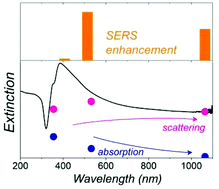Silver nanowires as infrared-active materials for surface-enhanced Raman scattering†
Abstract
Surface-enhanced Raman scattering (SERS) is increasing in significance as a bioanalytical tool. Novel nanostructured metal substrates are required to improve performances and versatility of SERS spectroscopy. In particular, as biological tissues are relatively transparent in the infrared wavelength range, SERS-active materials suitable for infrared laser excitation are needed. Nanowires appear interesting in this respect as they show a very broad localized surface plasmon resonance band, ranging from near UV to near infrared wavelengths. The SERS activity of silver nanowires has been tested at three wavelengths and a fair enhancement at 1064 and 514 nm has been observed, whereas a very weak enhancement was present when exciting close to the nanowire extinction maximum. These experimentally measured optical properties have been contrasted with finite element method simulations. Furthermore, laser-induced optoacoustic spectroscopy measurements have shown that the extinction at 1064 nm is completely due to scattering. This result has an important implication that no heating occurs when silver nanowires are utilized as SERS-active substrates, thereby preventing possible thermal damage.



 Please wait while we load your content...
Please wait while we load your content...